Hitting Biomechanics
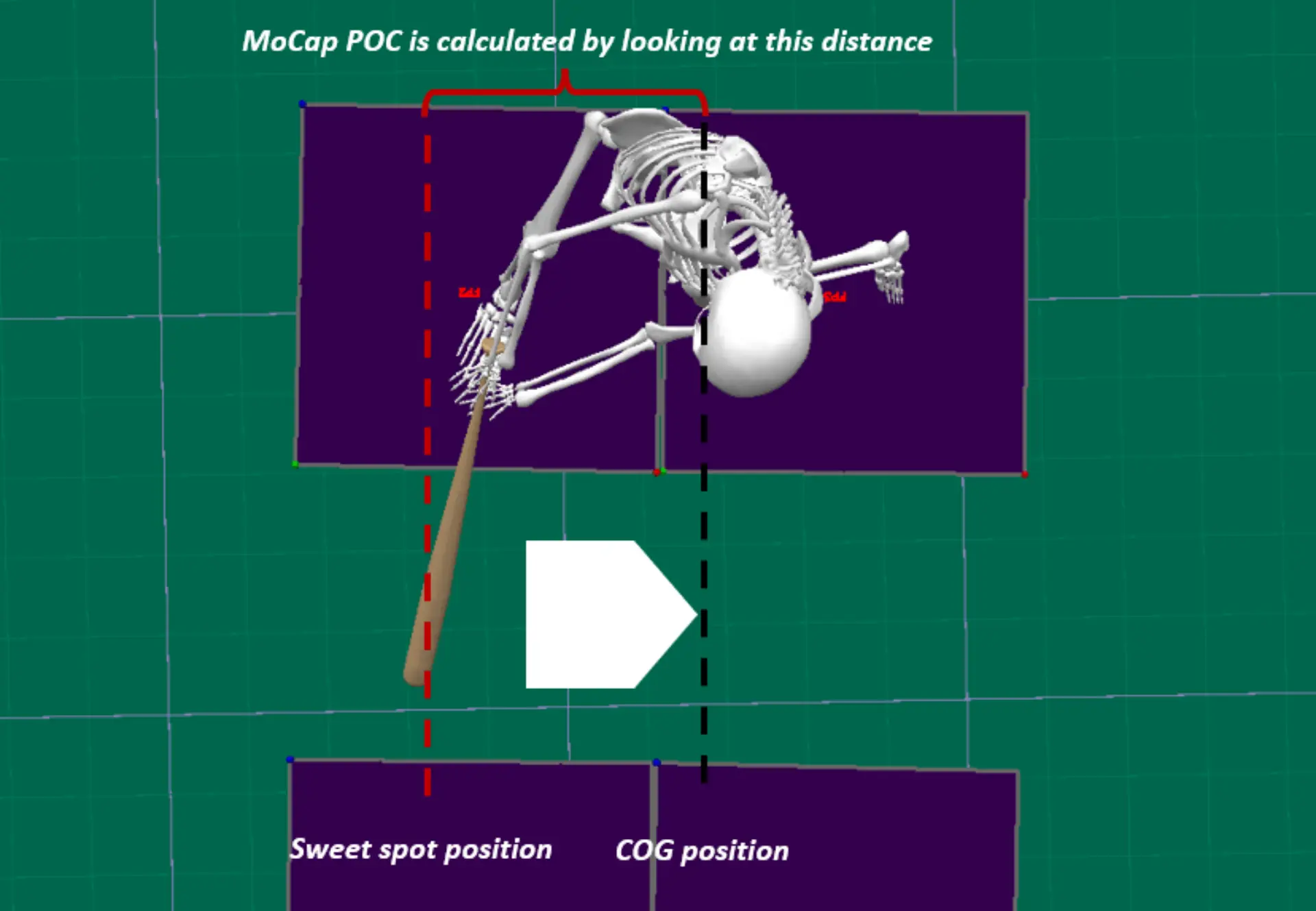
Bat Speed, Point of Contact, and Rotational Velocities
Since finalizing the hitting set-up in our motion capture lab (The Launchpad) in July of 2021, we’ve had hundreds of hitters come in for a motion capture assessment, including multiple MLB All Stars and top collegiate and pro prospects. At the time of writing, Driveline has collected biomechanical data on over 2,000 swings across a wide range of player talent from high schoolers up to some of the best hitters in the MLB.
This gives us a rich and unique database to help us answer the question: what separates the best hitters in the world from their peers?
Countless books could be written on all the challenges we’ve encountered and the failures we’ve made getting to this point; however, from those lessons we find ourselves well positioned to leverage our growing database and the hitting biomechanics insights are beginning to trickle in. So let’s take a look at a few quick ones!
Blast Motion vs. Motion Capture
One of the coolest aspects of hitting motion capture is that we are able to collect all sorts of high-fidelity, full signal data on bat characteristics during the swing. For example, we are able to see what a hitter’s bat speed or attack angle is at any given point in the swing (see figures 1 and 2). This gives our trainers a full picture of what an athlete is doing rather than needing to rely on discrete metrics at impact to infer swing and path quality.
Figure 1. Full signal bat speed data showing how fast the sweet spot of the bat is moving at every point in the swing.
Figure 2. Full signal attack angle data can give a better idea of a hitter’s bat path throughout the entirety of the swing.
Using tools like Blast Motion bat sensors on a daily basis gives us immediate feedback during a training session, but swinging in the Launchpad allows for greater precision and detail. Much of the guesswork that comes from looking at video can be removed, helping our trainers more precisely pinpoint what a hitter does well and what they need to improve.
The precision of the lab also means we can obtain more consistent reads on things like bat speed or attack angle and full signal body + bat kinematics, while avoiding variance due to incorrect sensor placement. This last point can be seen by looking at the differences in the standard deviations of paired bat speeds measured with Blast and our mocap lab. These differences may not look huge at first glance, but when you consider that these values were calculated after removing any obvious misreads from Blast, the differences appear pretty eye-opening.
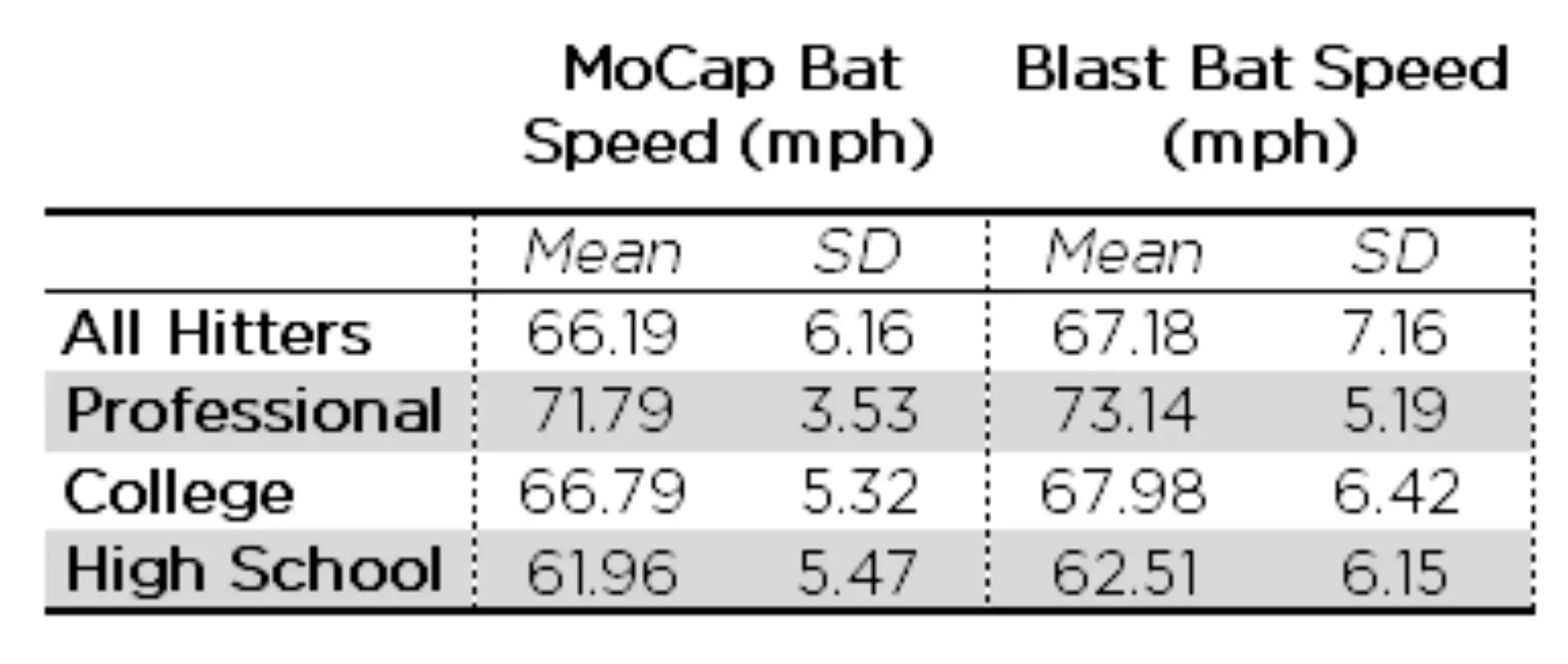
Bat Speed
We’ve already talked quite a bit about the importance of bat speed in several blogs authored in the past, and in the table below one can see that our results from the Launchpad provide even more evidence as to why this is the case.

We see that, on average, our pro hitters swing the bat just under 72 mph, which is about 4 mph faster than our college hitters and almost 10 mph faster than our high school hitters. Not surprisingly, our pro hitters also hit the ball about 6 mph harder than our college hitters in the lab and about 12 mph harder than our high school hitters on average.
We can also see from the distributions below that there is much less variability in bat speed and exit velocity among professional hitters when compared to both college and high school hitters. The key takeaway here is that as batters move up in playing level, they must swing the bat faster and hit the ball harder than a certain threshold.
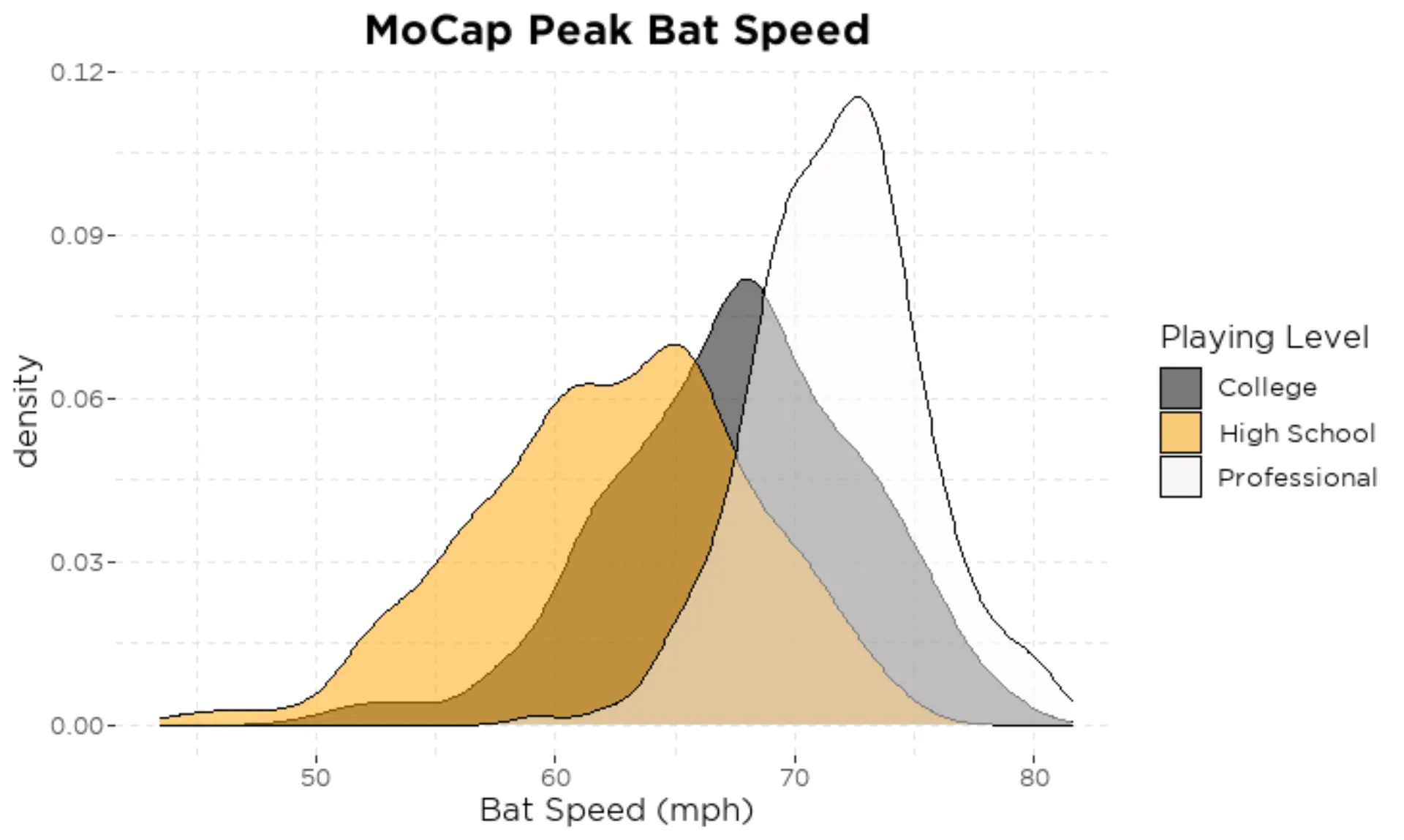
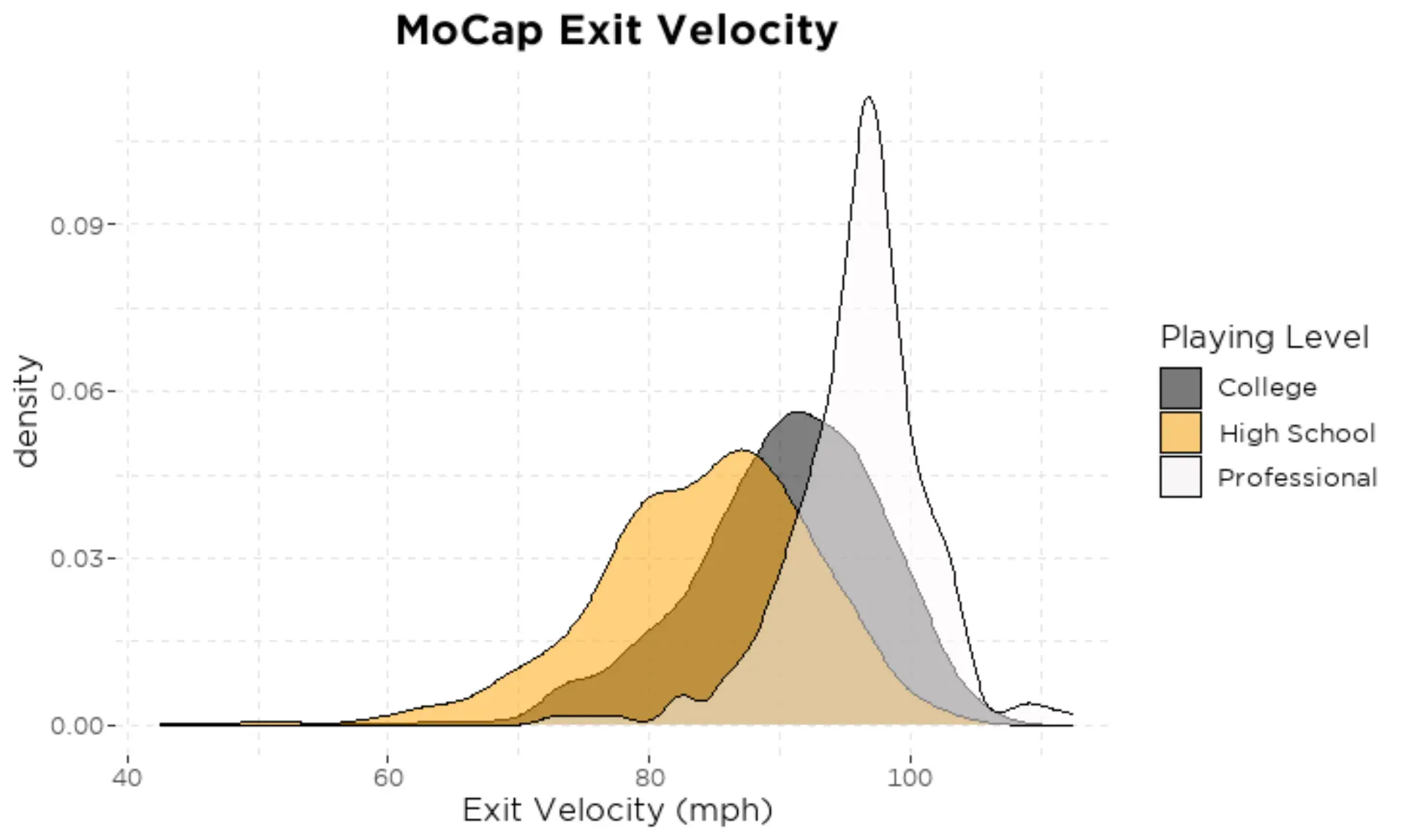
Point of Contact
HitTrax and similar technologies define POC as the point where contact is made relative to home plate. While this metric does provide a lot of useful information, it does have some limitations due to the fact that not every hitter stands in the exact same spot in the batter’s box or has the same length stride. This can make it a bit tougher to compare one hitter’s POC to another’s. So what if we were able to measure POC relative to a hitter’s body?
Using our motion capture data we can use a hitter’s center of gravity (COG) to determine how far out in front or deep in the zone contact is made relative to that hitter’s body. We can simply calculate the distance between a hitter’s COG position and the position of the sweet spot of their bat to get what we will refer to as their MoCap POC (figure 5).

Every hitter knows the feeling of hitting a ball too deep in the zone or too far out in front and will be able to tell you that these different swings are going to yield much different results. For example, this is a swing from our lab with one of the deepest points of contact:
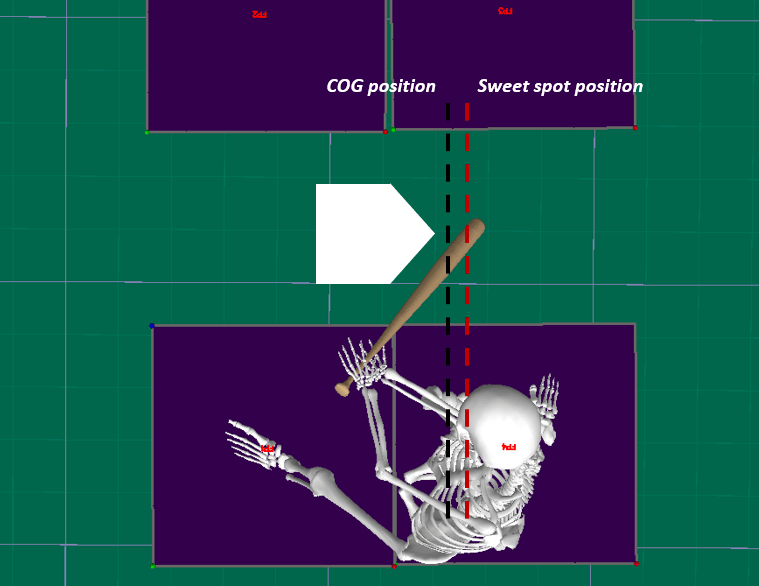
Compare that to another swing from our lab which had the furthest POC in our database:
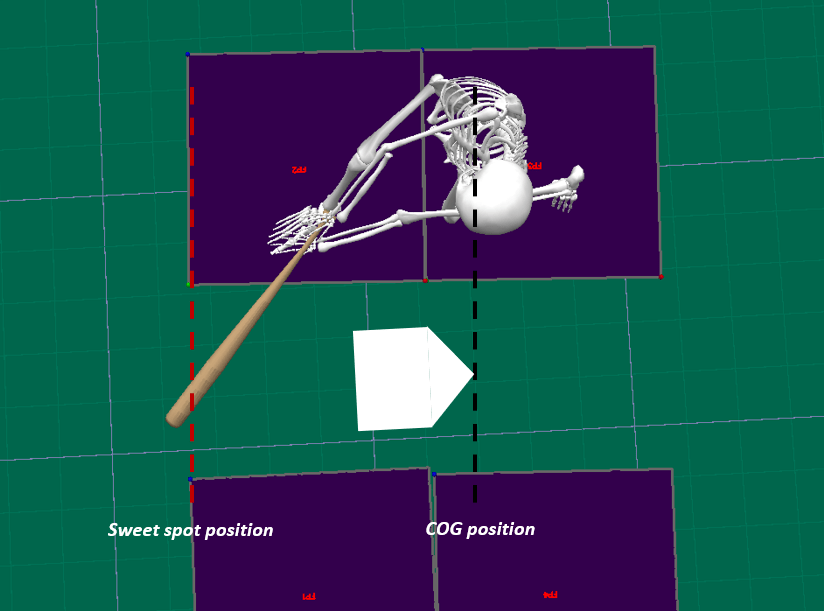
These two swings are going to result in much different spray and launch angles and, as we will see shortly, would likely have much different bat speeds.
Because hitting is so reaction-based and largely dependent on the incoming pitch, we expect there to be much more variation from swing to swing. Measuring POC relative to the body gives us one way to compare similar swings across different athletes.
When looking at POC across different levels of play we see an interesting trend where POC increases with playing level. The plot below shows the distribution of POC split up by playing level.
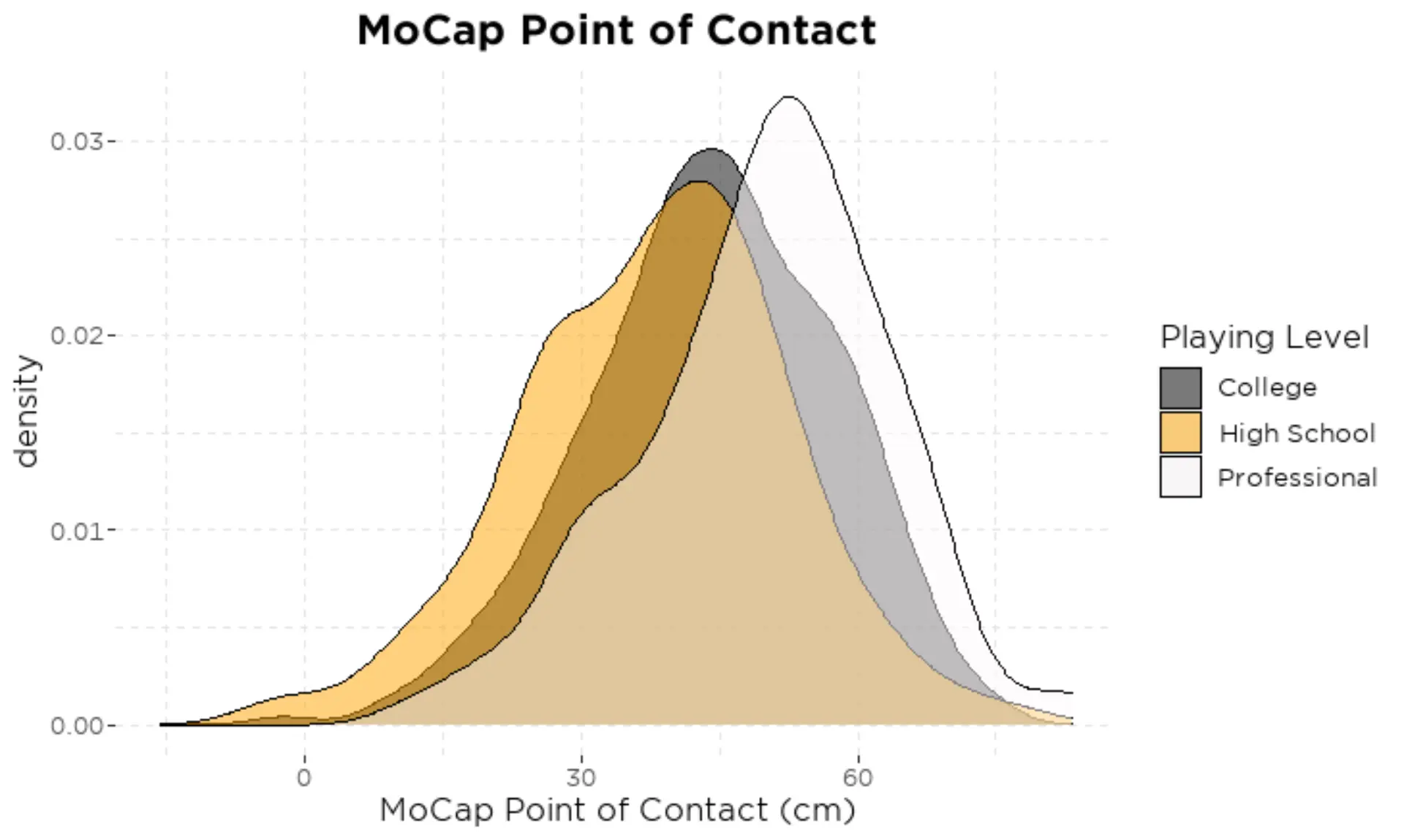
High school hitters tend to make contact almost 12 cm (or about 5 inches) deeper in the zone relative to their body when compared to professional hitters. However, this may not be a generalizable trend that we would observe outside of our lab. During motion capture assessments, we set up the pitching machine 45 feet from home at a standard setting of 65 mph. One possible explanation is that it is marginally easier for hitters at higher levels to hit against these settings than lower level hitters and, thus, why we see POC increase with playing level.
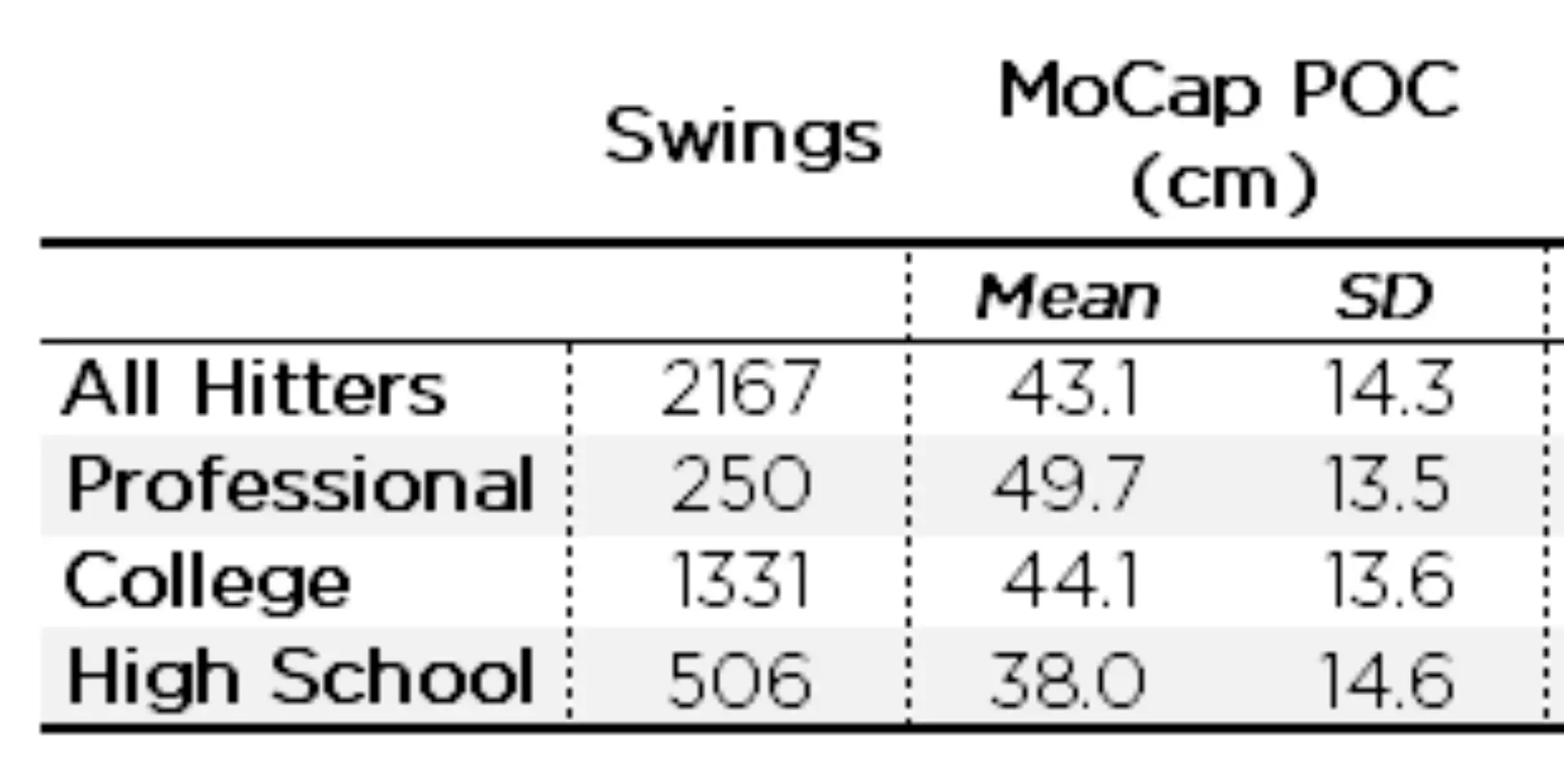
Nevertheless, we see that, on average, POC gets slightly farther out in front as you go up in playing level. Whether this is a result of us controlling the difficulty of the incoming pitch or not is hard to say, but it’s likely that this trend doesn’t hold in the same way in more game-like settings at different levels of play.
Why Power Hitters Live Out In Front
Ask any hitter and most will tell you it’s much easier to hit a home run to the pull-side than to the opposite field. Taking a look at POC and its relationship to bat speed gives us some insight into why it may be easier to hit the ball harder to the pull-side.
Hitting a ball to the pull-side requires a POC that is farther out in front of the body than hitting a ball to the opposite field. This will likely result in a slightly higher bat speed than if contact was made deeper in the zone. When we plot MoCap POC against bat speed we see that there is a positive linear relationship where bat speed increases with POC when comparing swings from different hitters (figure 9).
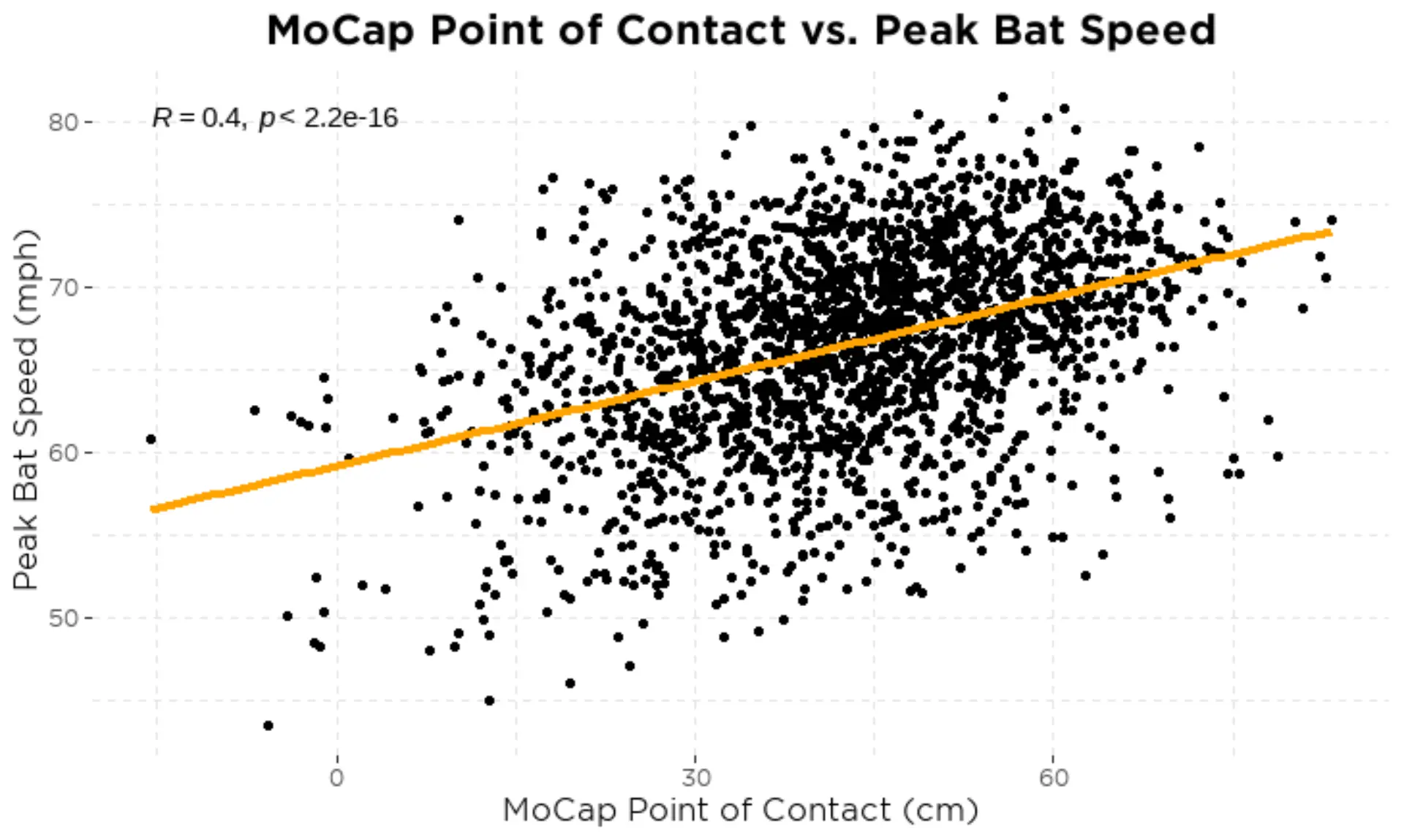
This relationship intuitively makes sense as the bat has more time to accelerate the farther out in front contact happens. When we control for a player’s average bat speed and average point of contact – to further tease out the expected effect if an athlete were to make contact further out in front on some of their swings – we see that this trend remains where an increase in POC is associated with an increase in bat speed.
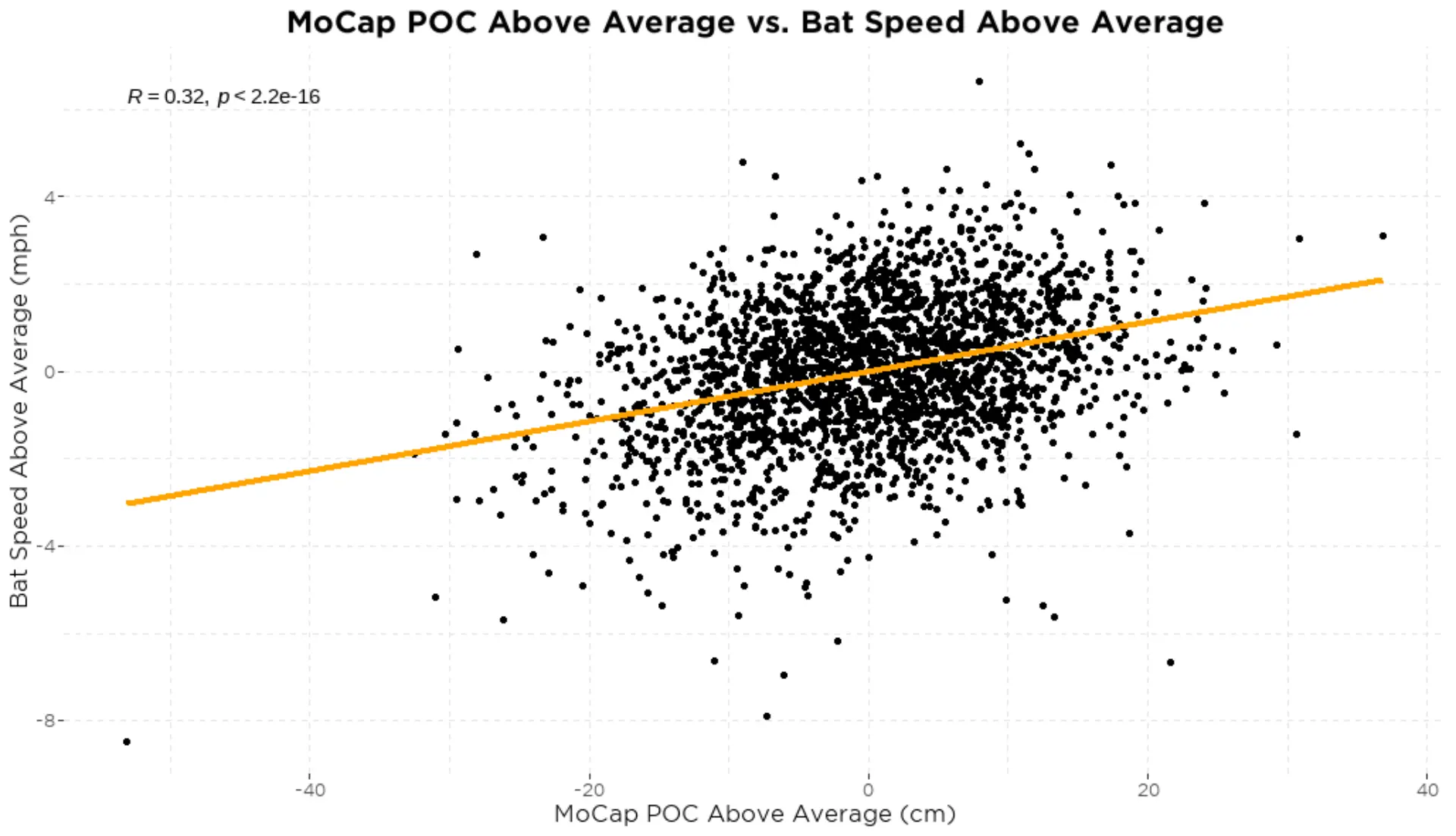
Using that relationship plotted in figure 10, an additional 10 cm (~4 inches) of POC corresponds with an increase of approximately 0.6 mph for that athlete. Now, this isn’t necessarily to say that everyone should be trying to make contact as far out in front as possible to maximize their bat speed. In fact, there are going to be trade-offs with making contact farther out in front such as a higher attack angle (see figure 11).
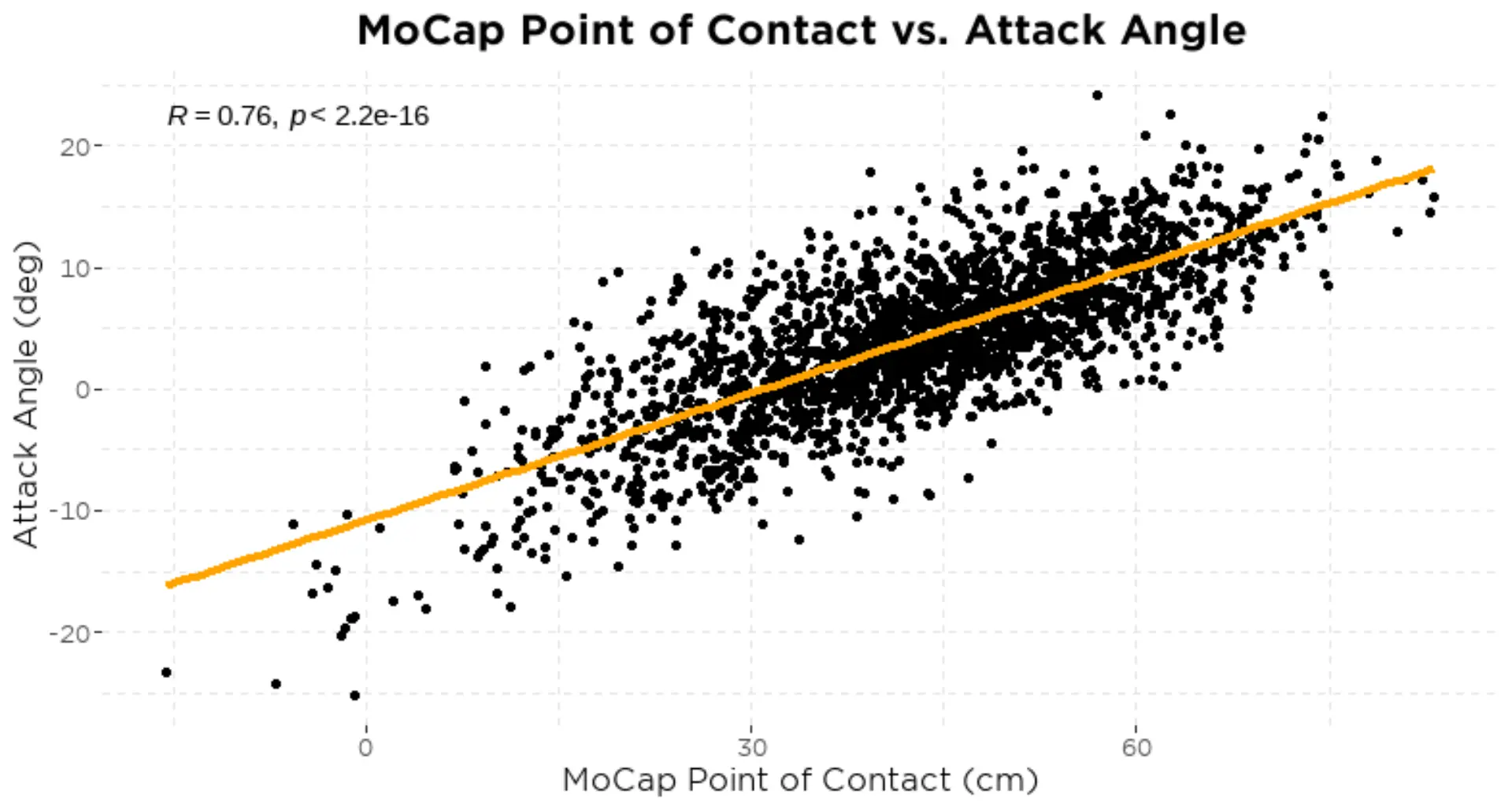
Sequencing Efficiently
Motion capture allows us to not only track the movement of the bat during a swing, it also allows us to track different segments of the body and see how they may influence the swing. One of the more common ways to determine how efficiently a player moves during a swing is to look at how fast and in what sequence they rotate their body. We typically look at the angular velocity of the pelvis, torso, upper arm, and hand to get an idea of how well a hitter uses their entire kinetic chain to create bat speed. Ideally a hitter will have a sequence that looks something like this:
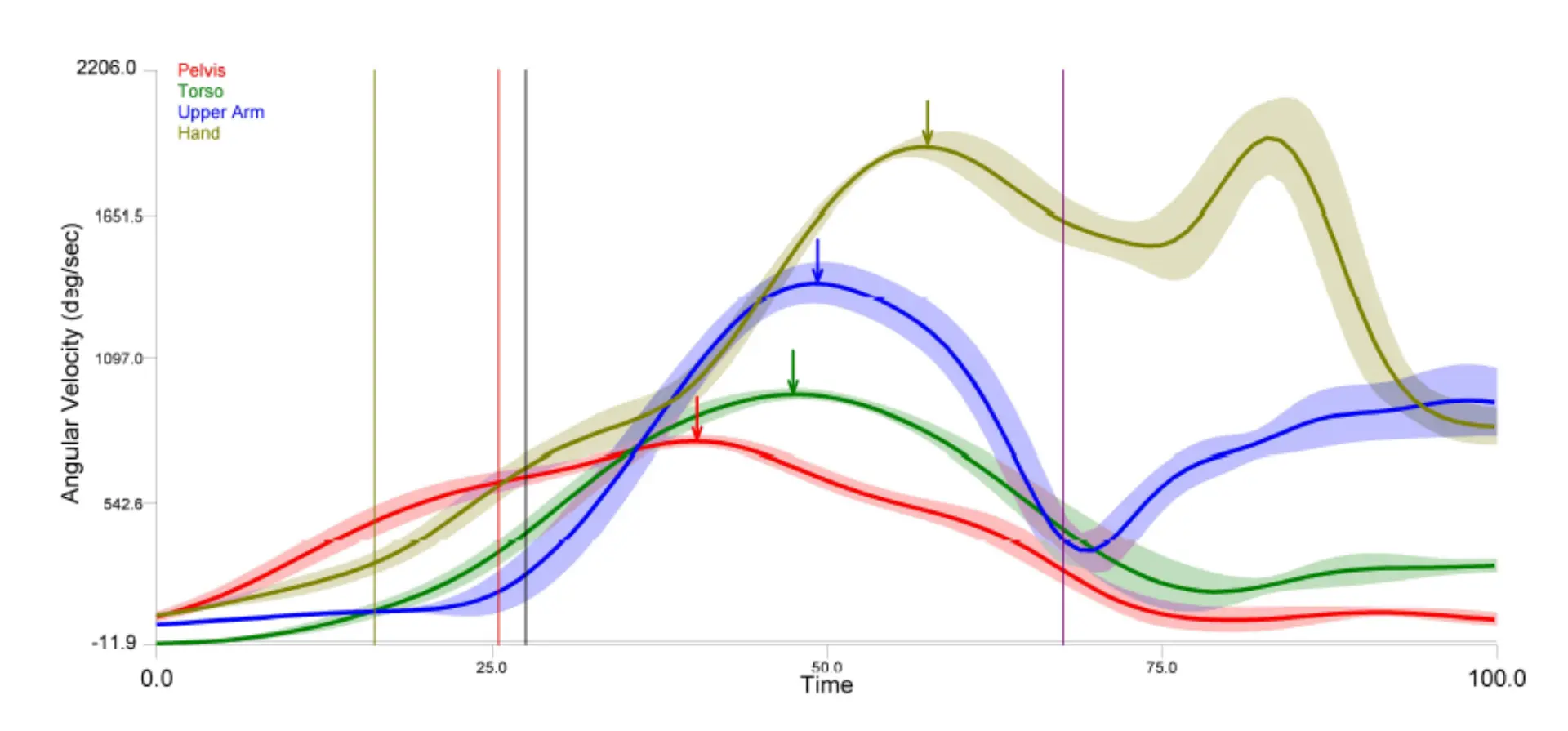
We see here that the segment velocities peak in order as we move up the chain from the pelvis, to the torso, to the arm, and to the hands. In this way, each subsequent body segment builds off of the velocity that was generated by the previous segment. For more context, the visuals below demonstrate exactly what we are looking for when we talk about angular velocities of different body segments sequencing efficiently:
Figure 13. Pelvis angular velocity measures how quickly the pelvis (highlighted segment) rotates during the swing.
Figure 14. Torso angular velocity measures how quickly the torso (highlighted segment) rotates during the swing.
Figure 15. Upper arm angular velocity measures how quickly the upper arm (highlighted segment) rotates during the swing.
Figure 16. Hand angular velocity measures how quickly the hand (highlighted segment) rotates during the swing.
Moving Fast = Hitting the Ball Harder
Perhaps unsurprisingly, a relatively straightforward observation we’ve been able to make with the data we’ve collected in The Launchpad is that rotating faster is correlated to swinging the bat faster and hitting the ball harder. The table below shows a handful of rotational velocity metrics and their relationship to both bat speed and exit velocity:
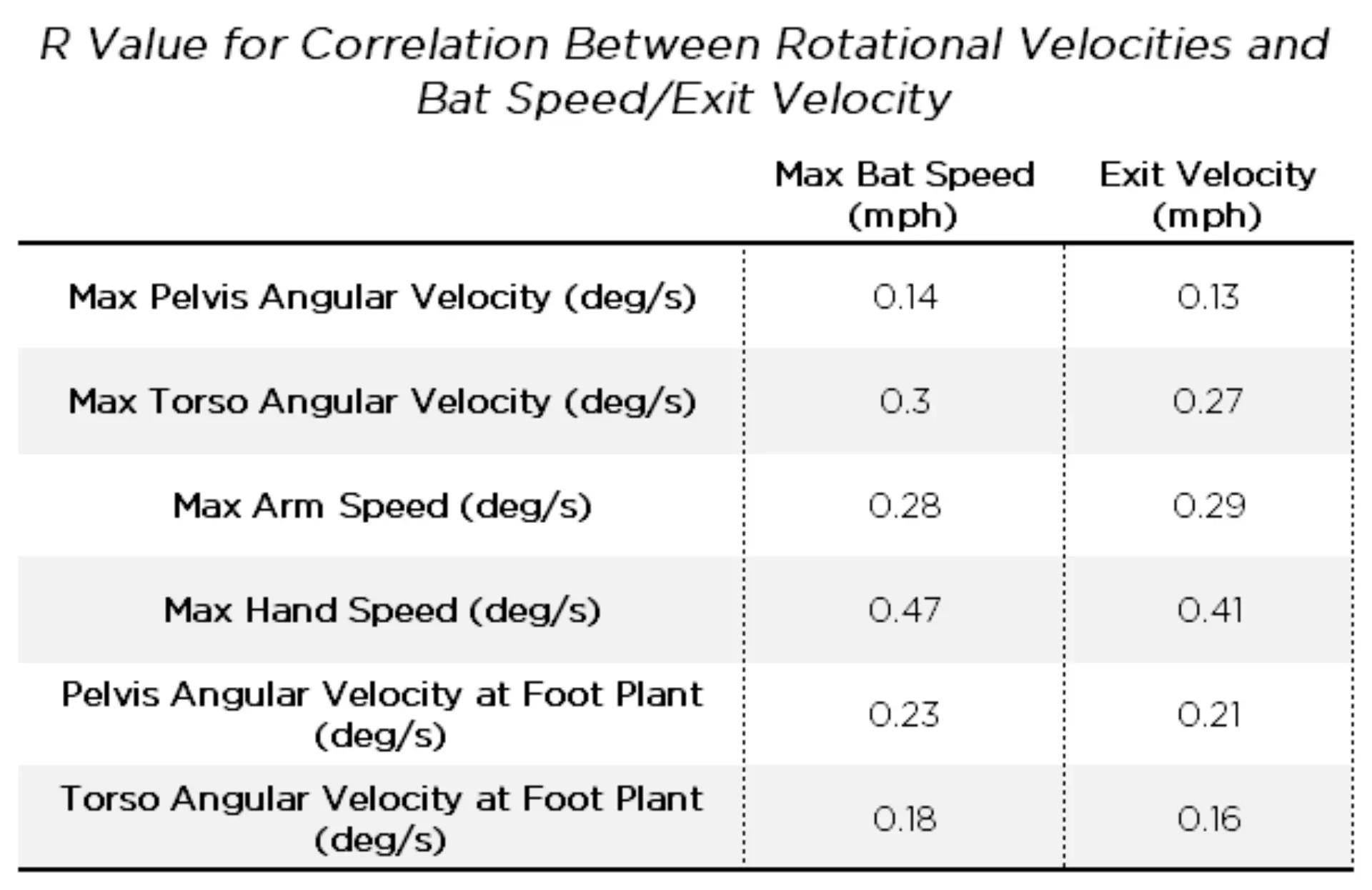
All six of these rotational velocity metrics are significantly correlated to both bat speed and exit velocity at contact. Thus, the faster these segments rotate, the faster the bat moves and the harder the ball is hit.
Interestingly, the relationship between rotational velocity and bat speed / exit velocity gets stronger the further one moves up the chain (or toward the bat). So, it may be possible for an athlete to overcome slower pelvis and torso rotational velocities with higher arm and hand speeds later in the swing to generate bat speed.
Another interesting takeaway from this table is that max pelvis angular velocity has a weaker correlation to bat speed and exit velocity than pelvis angular velocity at foot plant. In other words, it may be more important that the pelvis is moving quickly as a hitter lands with their lead leg than it is to max out pelvis rotational velocity at any other point during the swing.
To get a sense of just how fast hitters in our lab are moving, take a look at the table below. In doing so, you’ll see that the correlations discussed above seem to hold true when looking across all playing levels.

Just like with bat speed, we see that rotational velocities appear to increase with playing level with larger differences in arm and hand speeds.
What’s Next?
With our initial foray into hitting biomechanics, we confirmed some of the more basic hypotheses related to the fundamentals of hitting. Better hitters swing harder, make louder contact, live further out in-front when hitting pitches of equal difficulty, and rotate faster / more efficiently. With these truths supported, we’ll leverage The Launchpad to help us investigate questions and quantify mechanical characteristics we were previously unable to. A primary point of interest in our future research will be in understanding and quantifying what makes for an efficient and optimal bat path. Along with this we hope to learn more about how different mechanical attributes influence batted ball outcomes. Stay tuned for more insights into hitting biomechanics as we dive deeper and deeper into the data!
Comment section
Add a Comment
You must be logged in to post a comment.
Tyson -
Great data. Do you mind if I make a suggestion? A summary of points along with action items that the reader could implement based on your finding.
That said, the takeaway I have is:
-Work on speed and moving fast
– improve strength and rotational abilities
-when possible, hit the ball out in front of the plate as it allows time for bat speed to pick up
Anything I missed?
bubabaseball -
Figure 1 (attack angle graph) is the most interesting to me here. Looks like you feel the same way with your conclusion statement “A primary point of interest in our future research will be in understanding and quantifying what makes for an efficient and optimal bat path”. If an athlete’s goal is to match attack angle with the reverse incoming pitch angle, looks like the attack angle accelerates to that angle within milliseconds. How to train for that? We will see what you find.